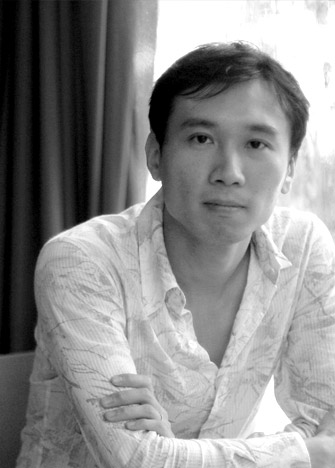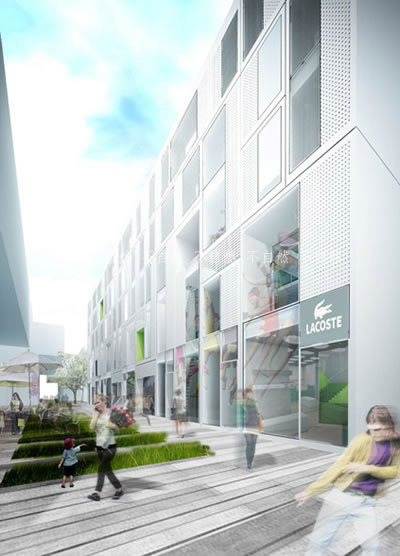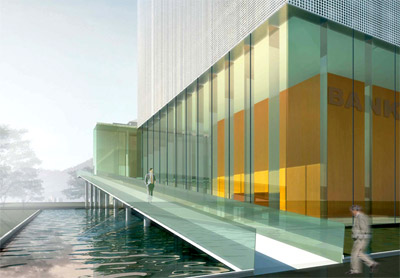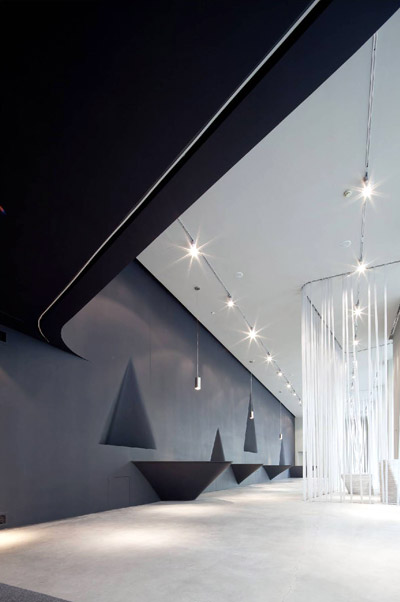
对话:何健翔
采访:Elena 伍星
被采访:何健翔源计划建筑师事务所主持建筑师
Chief architect of studio O-office architects
ID:您是如何理解自然与不自然?How do you comprehend the natural and unnatural?
何健翔:若仅从字面理解,“自然”和“不自然”是一对反义词,语义上相互对立。但事实上,不管是东西方,这种对立在空间和营造范畴里并不存在。在传统东方的观念里,自然高于一切,空间上师法自然是营造和技艺的最高境界,因此“不自然”的对象和目标永远是“自然”,这在我们传统的山水绘画中表达得淋漓尽致。在西方,人们尊崇秩序,深信某种终极秩序,自然界表象虽千变万化,内中却隐含着某些基本法则和秩序。因此空间营造就是营造秩序,秩序是抽象的自然,而建筑则是物化的秩序,“不自然”是物化的“自然”。虽受人本中心论影响,建筑和绘画上强化人工和自然的对立,但两者在哲学上同源。若按当今主流思想倾向于去除人本中心论,人也是自然之组成部分,那人为(不自然)也从属自然了。
Literally, Natural and Un-natural are apparently antonymous and opposite. But, philosophically, this opposition does not exist in the scope of space and architecture, either in eastern or western tradition. In eastern tradition, Natural surmounts all the rest of the world. Learning from nature is regarded as the top level in space making, and thus Natural is always the objective of Un-natural. This has been well demonstrated among ancient Shan-Shui paintings. While in western tradition, people respect to order, believing in the ultimate physical rule regardless of the complex presentation of the world. Making space is therefore making orders; orders are the abstract nature; architecture should be materialized orders, and Un-natural ought to be materialized Natural. The above two are philosophically isogenous, although, for long influenced by anthropocentrism,artificiality and nature are always been set in opposition in art and architecture. Today, all theorists have taken the position in non-anthropocentrism. Human is regarded as part of the nature, and naturally, Un-natural should be part of Natural.
ID: 回过头来再次看"白云国际会议中心”这个项目,您有什么想法或者说想完善它的地方?
When you relook the project BICC (Baiyun International Conference Center), is there any new possibility or something to be improved?
何健翔:要谈建筑,尤其像“白云国际会议中心”这种超大规模建筑,我们无法孤立地谈建筑学,真正影响和决定建筑进程通常是人们的观念和由这种观念所生成的社会机制。这种情况导致了“白云会议中心”的建造结果与建筑师的很多想法背道而驰,如果套用我们今天的话题就是一个“自然”主义的议题最终却呈现极“不自然”的结果——建筑与环境分离,功能与城市分离,政治与生活分离,权力与公众分离,其结果必然是建筑生命的缺失,如同所有我们城市中的大型建筑一样。因此如果人们不改变固有的观念,仍然仅将建筑看作是某种主观现实意识的再现,而不是把建筑看作为我们城市获得新可能性的机会,建筑将永远被绑架,永远难以获得真正存在。
We cannot talk about architecture alone when talking about buildings, especially large-scale buildings like BICC. In Chinese context, the decisive factors in the building process are mostly the collective ideology and the social-economic mechanism from this ideology. As the result, the final building of BICC was more or less going on the opposite side of the original concept. The “natural” idea of BICC was completed in a very “un-natural” way: architecture isolated from the environment, functionality isolated from the city, politics isolated from city life, and power isolated from the public. Architecture in this case, like all other large-scale public buildings in the city, is a petrified object. If we continue to see architecture merely as representation of our subjective notion, instead of new possibilities for the city, architecture would always be kidnapped and never find its own existence.
ID:与EMG几个城市的展馆合作,每一次的设计会有什么不同或新的特色?
Having collaborated with the pavilions of EMG in difference cities, do you have any new experience to share?
何健翔:我们作为建筑师与EMG合作已经有4年,到现在已经是第五回。建筑师与相同的业主在这么短的时间内如此频繁地合作,关键问题已经不是怎样相互理解和顺畅沟通(没有这种默契根本无法长期合作),反而是如何能够保持相互适度的距离和陌生感,从而保证每次合作的新鲜度和创作的投入度。每个新项目对上一个项目运行的解读是新旧项目间贯穿的线索,而场地以及城市背景的差异将是合作距离和陌生感的基础所在。
广州大石馆的场地是珠江边上的早期工业遗址,北京大石馆的场地是东五环附近一幢廉价新建的标准厂房,上海则是北郊一幢多层厂房的首层空间,深圳大石馆又是郊区住宅的裙房单元,而这几个中国目前最大城市的地理、文化、气候的诸多差异正正赋予我们每个项目设计的文化基因,由此生长出来的建筑空间自然渗透了场地和城市的养分而呈现不同气质。
目前正在进行的威尼斯大石馆对原先的大石馆系列而言无论从场地和城市背景都完全是个异类,在一个全新的城市文化背景中设计对我们是个新的课题。设计会跟广州和威尼斯两个相互远离但关联的城市都相关,在这里我先卖个关子,等设计完成后再跟你们讲述这个故事。
We have been working with EMG for more than 4 years as an architect. It is now the 5th time we collaborate. The key issue for an architect collaborating with the same client frequently in such a short period is no longer communication or understanding, but how to maintain distance and Jamais vubetween each other, in order to guarantee freshness in collaboration and design creation. Rethinking on the operation of the former project constitutes the clue connecting the past project to the current one, while the new site and urban background nourish the above mentioned necessary distance and Jamaisvuin the new design process. Guangzhou stone gallery, the first of EMG’s gallery series, were renovated from an abandoned 1960’s industrial workshop building; Beijing stone art center was renovated from a cheap new-built loft building; Shanghai design center was located in the ground floor of a multi-level industrial building in the north of the city; Shenzhen gallery is building now in a bottom unit of a high-rise residential community. Each of them is born from its unique site and urban background, being shaped and nourished by each city’s urban culture.
The on-going Venice Gallery, compared to all the former projects, is completely a new place. Designing a project in a unique European antique city to us is a fresh topic too. Our design will link to two apparently remote places – Guangzhou and Venice – together, and tell a lovely spatial narrative. I will let you know when it is completed.
ID:能否谈谈您这次“不自然2”的创作方向?
Could you talk about the idea of your creation in Un-natural II?
何健翔:“不自然2”我本来是分到人造石一组,后来我想我应该打破这个分组,原因一方面是我跟EMG多年的合作关系,使我无法完全抽离而置身度外,另方面是由于我觉得天然石材的加入能让我的作品更好地表述我之前所提到的“自然——不自然”的语义关系。在我的作品中,“不自然”的人造石人为地被柔化成接近液态的“自然”状态,“自然”的天然大理石则由于人工雕琢而“不自然”。两者相对而置,人们将在“自然”中看到不自然,在“不自然”中领悟自然。人造石的“自然”塑形完全由人工编制的电脑程序控制——从电脑模型雕刻出模具,之后在模具中浇注出“水”样;天然大理石的成型则由工匠根据设计意象凿刻打磨而得——设计初稿被制成实体模型小样,工匠依据小样形态结合自身的经验和手感雕琢成岭。既自然,也不自然……作品取名“薄山水”。
In Un-natural II, I should belong to the group of artificial stone. But later I thought I should go beyond this limitation, partly because of my emotion to natural stone which seemingly came from my close collaboration with EMG, and partly because I felt the joining of natural stone and artificial stone can reinforce my above mentioned thought on the philosophical relation of “Natural” and “Un-natural”. In my work, “un-natural” Corian material is artificially softened to a nearly natural liquid form, while “natural” marble is carved to a somehow “un-natural” status. One will be floating above the other. You may discover the un-natural in “Natural”, and may understand natural among the “Un-natural”. The “natural” form of the artificial stone is completely controlled by computer programs; the mold for the liquid surface form is made by CNC engraving machine. The working process for the marble is a combination of the architect’s conceptual sketches and the craftsmen’s experience and feeling of their hands on the stone. Hereby, Natural, while un-natural… I will name this work “Thin Shan-Shui”.
 万科-Nai北京回龙观微型实验住宅
万科-Nai北京回龙观微型实验住宅 南宁科技馆
南宁科技馆 南华糖业(集团)总部办公楼
南华糖业(集团)总部办公楼 EMG上海设计展示中心
EMG上海设计展示中心

